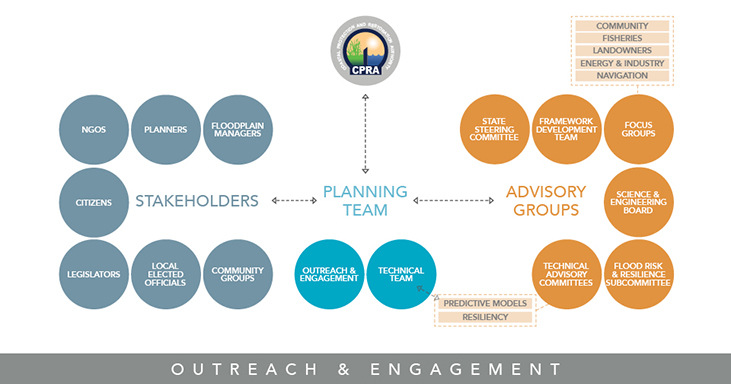Sign Up. Stay Informed.
Working Together
CPRA engaged with the public and a diverse group of key stakeholders to help establish a clear vision for the 2017 Coastal Mater Plan. Stakeholder groups, listed in detail below, are key partners in helping to determine how best to meet the state’s current restoration and protection needs and adapt to future conditions.
Public Outreach: Community Conversations
The master plan team met with community groups and members of the general public several times throughout the master plan development process. During spring 2015 and spring 2016, CPRA hosted a series of eight “Community Conversations” across coastal Louisiana to hear residents’ perspectives about successful flood risk mitigation efforts, including what has worked well and what could be improved. During the fall of 2016, an additional seven community meetings were held in partnership with local community organizations. These community conversations were designed to receive feedback on draft lists of potential projects and used information from project modeling and alternative formulation to inform facilitated discussions. The valuable feedback from these discussions was then used in the development of the draft master plan. Lastly, CPRA held a series of public hearings and community meetings in January-March 2017 to solicit further feedback on the draft plan.
In total, CPRA held over 170 briefings with the public, community groups, local officials, advisory groups and others in the plan development process.
Framework Development Team
The Framework Development Team (FDT) serves as the primary collaborative group supporting and providing insight and counsel to the Planning Team. The FDT membership draws upon individuals, most of whom live in Louisiana and are intimately familiar with our coastal crisis. The FDT consists of representatives from federal, state, and local governments; NGOs; business and industry; academia; and coastal communities. FDT members offer specific guidance on all of the major elements of the 2017 Coastal Master Plan and, as key advisors, they work collaboratively to identify, discuss, and reach a common understanding about the tough choices that lie at the heart of protecting and restoring Louisiana’s coast. FDT members are tasked with reaching out to citizens who share their interests, bringing these citizens’ ideas to the table and, later, reporting back to these citizens about how their ideas were discussed and addressed in the 2017 Coastal Master Plan. In this capacity, the FDT serves as an important distribution network for early-stage communications.
To view the list of members, click here.
Science and Engineering Board
The Science and Engineering Board (SEB) includes scientists and engineers with national or international experience who cover the range of disciplines addressed in the 2017 Coastal Master Plan. The SEB provides independent technical review of plan elements and makes specific recommendations about how the Planning Team can improve the scientific basis and/or planning elements to create the most credible approach. The SEB meets in formal sessions two to three times a year and may meet via webinar and/or in smaller workgroups.
To view the list of members, click here.
Technical Advisory Committees
Technical Advisory Committees (TACs) are small advisory groups made up of nationally known academics and practitioners that offer insight into specific elements of the master plan process. The 2017 Coastal Master Plan includes two technical advisory committees that focus specifically on 1) community resilience and nonstructural implementation, and 2) technical modeling and analysis.
The Resiliency TAC offers working-level guidance and recommendations on the programmatic and policy measures needed to implement a comprehensive flood risk and resilience program. The Resiliency TAC is composed of experts in the areas of climate adaptation planning, community planning, socio-economics, social vulnerability, and hazard mitigation, disaster planning, and environmental policy.
The Predictive Models TAC advises the planning and technical teams working to improve the analytic tools that assess how the coastal Louisiana landscape will change over the next 50 years, and that help to prioritize effective protection and restoration projects that comprise the master plan. In addition, the Predictive Models TAC advises the technical team working to implement the Model Improvement Plan.
To view the list of members of each TAC, click here.
Focus Groups
Large-scale coastal protection and restoration will affect businesses and industry in south Louisiana. To integrate the perspectives of those in key business sectors, the Planning Team has created/reconvened five focus groups, one focused on each of the following areas: community, fisheries, landowners, energy and industry, and navigation.
The groups meet regularly with the Planning Team to discuss topics centered on plan development and implementation options for projects in key areas. The focus groups are part of CPRA’s effort to expand its engagement of key stakeholders and to receive and incorporate their input into the 2017 Coastal Master Plan. At least one member of the Framework Development Team (FDT) supports each focus group, and results from the focus groups’ deliberations are reported at FDT meetings.
To view the list of focus group members, please click here.
For a full list of public meetings, key briefings, and to read summaries of the deliberations from the Framework Development Team, Focus Groups, Science and Engineering Board, and Technical Advisory Committees, please see Appendix G: Outreach and Engagement.

